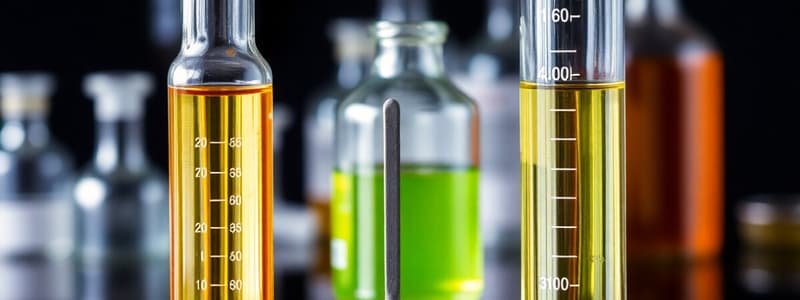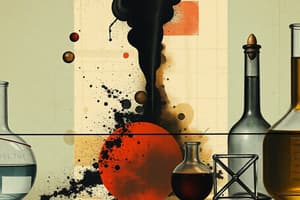Podcast
Questions and Answers
What happens to the equilibrium when the concentration of reactants is increased?
What happens to the equilibrium when the concentration of reactants is increased?
- The equilibrium shifts completely to products.
- The equilibrium remains unchanged.
- The equilibrium shifts to the left.
- The equilibrium shifts to the right. (correct)
According to Le Chatelier’s principle, what effect does decreasing the pressure have on a gaseous equilibrium system?
According to Le Chatelier’s principle, what effect does decreasing the pressure have on a gaseous equilibrium system?
- It shifts the equilibrium to the side with fewer moles of gas.
- It causes a complete reaction to products.
- It does not affect the equilibrium.
- It shifts the equilibrium to the side with greater moles of gas. (correct)
What does the formula PV = nRT represent in the context of gas equilibrium?
What does the formula PV = nRT represent in the context of gas equilibrium?
- Ideal Gas Law. (correct)
- Phase Transition Principle.
- Equilibrium Concentration Law.
- Boyle's Law.
When the equilibrium is disturbed by an increase in product concentration, what will the system do?
When the equilibrium is disturbed by an increase in product concentration, what will the system do?
If the volume of a gas system is decreased, what will be the expected effect on equilibrium?
If the volume of a gas system is decreased, what will be the expected effect on equilibrium?
What is the effect of increasing pressure on the equilibrium of the reaction 2PbS (s) + 3O2 (g) ↔ 2PbO (s) + 2SO2 (g)?
What is the effect of increasing pressure on the equilibrium of the reaction 2PbS (s) + 3O2 (g) ↔ 2PbO (s) + 2SO2 (g)?
In an exothermic reaction, how does an increase in temperature affect the equilibrium position?
In an exothermic reaction, how does an increase in temperature affect the equilibrium position?
Which of the following statements regarding endothermic reactions is true?
Which of the following statements regarding endothermic reactions is true?
What is the change in equilibrium constant (Kc) when the temperature increases for an exothermic reaction?
What is the change in equilibrium constant (Kc) when the temperature increases for an exothermic reaction?
Which equation illustrates the relationship between heat and endothermic processes?
Which equation illustrates the relationship between heat and endothermic processes?
For the reaction H2 (g) + CO2 (g) ↔ H2O (g) + CO (g), what happens to the equilibrium upon increasing the temperature?
For the reaction H2 (g) + CO2 (g) ↔ H2O (g) + CO (g), what happens to the equilibrium upon increasing the temperature?
What does a positive change in enthalpy (∆H > 0) indicate about a reaction?
What does a positive change in enthalpy (∆H > 0) indicate about a reaction?
In which scenario will increasing temperature favor the forward reaction?
In which scenario will increasing temperature favor the forward reaction?
What would happen to the equilibrium position if H2 gas is added to the Haber process?
What would happen to the equilibrium position if H2 gas is added to the Haber process?
Which of the following changes will NOT affect the equilibrium constant Kc for the reaction involving hemoglobin and oxygen?
Which of the following changes will NOT affect the equilibrium constant Kc for the reaction involving hemoglobin and oxygen?
In the context of the common ion effect, what would happen if CH3COOH is introduced into a solution already containing acetate ions?
In the context of the common ion effect, what would happen if CH3COOH is introduced into a solution already containing acetate ions?
When the volume of the system in the nitrogen and hydrogen reaction is decreased, what is the expected change in equilibrium position?
When the volume of the system in the nitrogen and hydrogen reaction is decreased, what is the expected change in equilibrium position?
What effect does adding an inert gas such as neon have on the equilibrium of a reaction?
What effect does adding an inert gas such as neon have on the equilibrium of a reaction?
What will happen to the equilibrium position of the reaction 4HCl (g) + O2 (g) ↔ 2H2O (g) + 2Cl2 (g) when the temperature is decreased?
What will happen to the equilibrium position of the reaction 4HCl (g) + O2 (g) ↔ 2H2O (g) + 2Cl2 (g) when the temperature is decreased?
Which of the following reactions will shift to the right with an increase in temperature?
Which of the following reactions will shift to the right with an increase in temperature?
What impact does the addition of a catalyst have on a chemical equilibrium system?
What impact does the addition of a catalyst have on a chemical equilibrium system?
In the reaction 2CO2(g) ↔ 2CO(g) + O2(g) -566 kJ, what will occur if the pressure is increased?
In the reaction 2CO2(g) ↔ 2CO(g) + O2(g) -566 kJ, what will occur if the pressure is increased?
What is the expected shift in the equilibrium of the reaction N2F4(g) ↔ 2NF2(g) when N2F4 gas is partially removed?
What is the expected shift in the equilibrium of the reaction N2F4(g) ↔ 2NF2(g) when N2F4 gas is partially removed?
What will happen to the equilibrium constant (Kc) in the reaction 2SO2(g) + O2(g) ↔ 2SO3(g) + 198 kJ when the temperature is decreased?
What will happen to the equilibrium constant (Kc) in the reaction 2SO2(g) + O2(g) ↔ 2SO3(g) + 198 kJ when the temperature is decreased?
If the pressure on the reaction H2(g) + Cl2(g) + 185 kJ ↔ 2HCl(g) is decreased, what is likely to happen?
If the pressure on the reaction H2(g) + Cl2(g) + 185 kJ ↔ 2HCl(g) is decreased, what is likely to happen?
For the equilibrium reaction CH4(g) + 2O2(g) ↔ CO2(g) + 2H2O(g) + 890 kJ, what effect does a decrease in temperature have?
For the equilibrium reaction CH4(g) + 2O2(g) ↔ CO2(g) + 2H2O(g) + 890 kJ, what effect does a decrease in temperature have?
What color change occurs when CoCl2 is reacted with HCl in the presence of a methyl red indicator?
What color change occurs when CoCl2 is reacted with HCl in the presence of a methyl red indicator?
What is the effect of adding NH4OH to the AgCl solution?
What is the effect of adding NH4OH to the AgCl solution?
According to Le Chatelier’s Principle, what happens to the equilibrium when additional HCl is added to the test tube containing CoCl2?
According to Le Chatelier’s Principle, what happens to the equilibrium when additional HCl is added to the test tube containing CoCl2?
In the reaction AgCl + HCl → AgCl + HNO3, what is the reaction type?
In the reaction AgCl + HCl → AgCl + HNO3, what is the reaction type?
What color does the solution become when CoCl2 is diluted with water after adding HCl?
What color does the solution become when CoCl2 is diluted with water after adding HCl?
What is the primary component that causes methyl red to change color in acidic conditions?
What is the primary component that causes methyl red to change color in acidic conditions?
What happens during the reaction of AgNO3 with HCl to form AgCl?
What happens during the reaction of AgNO3 with HCl to form AgCl?
What determines the shift in the equilibrium of Co(H2O)6+2 + 4Cl- ↔ CoCl42- + 6H2O?
What determines the shift in the equilibrium of Co(H2O)6+2 + 4Cl- ↔ CoCl42- + 6H2O?
Flashcards are hidden until you start studying
Study Notes
Experiment Overview
- Focuses on observing color changes and shifts in equilibrium during reactions.
- Utilizes Le Chatelier’s Principle to predict equilibrium shifts due to external stresses.
Concepts of Chemical Equilibrium
- Defined as a state where forward and reverse reaction rates are equal.
- Concentration of reactants remains constant over time.
Le Chatelier’s Principle
- States that a system at equilibrium will adjust to counteract applied stress.
- Stressors can include changes in concentration, temperature, pressure, and volume.
Changes in Concentration
- Increasing reactant concentration shifts equilibrium to the right.
- Increasing product concentration shifts equilibrium to the left.
- Example: In the reaction N2 + 3H2 ↔ 2NH3, adding NH3 shifts equilibrium left.
Changes in Volume and Pressure
- Boyle's Law states pressure and volume are inversely proportional.
- Ideal Gas Law relates pressure to the number of gas moles (PV = nRT).
- Increasing pressure (decreasing volume) favors side with fewer gas moles.
- Decreasing pressure (increasing volume) favors side with more gas moles.
- Example reactions:
- 2PbS + 3O2 ↔ 2PbO + 2SO2 shifts right (3 moles to 2 moles).
- PCl5 ↔ PCl3 + Cl2 shifts left (1 mole to 2 moles).
- H2 + CO2 ↔ H2O + CO has no shift (equal moles).
Changes in Temperature
- Enthalpy change (∆H) indicates heat of the reaction.
- Endothermic Reaction (+∆H): Heat absorbed, shift right with increased temperature.
- Exothermic Reaction (-∆H): Heat released, shift left with increased temperature.
- Example considerations for shifts due to temperature increase or decrease provided.
Effects of Temperature Changes on Specific Reactions
- Increased temperature affects equilibrium, favoring endothermic reactions and decreasing exothermic ones.
- Specific reactions analyzed to predict shifts upon temperature variation.
Adding a Catalyst
- Catalysts lower activation energy for both forward and backward reactions.
- Does not shift equilibrium or affect equilibrium constant (Kc).
Summary of Le Chatelier’s Principle
- Concentration: Yes shift, Kc unchanged.
- Temperature: Yes shift, Kc changed.
- Pressure & Volume: Yes shift (for gases), Kc unchanged.
- Catalyst: No shift, Kc unchanged.
Applications of Le Chatelier’s Principle
- High altitude effects on hemoglobin (Hb) and oxygen (O2) equilibrium.
- Haber Process: Key reaction for ammonia synthesis involving nitrogen and hydrogen.
Common Ion Effect in Experiments
- Effect of adding a common ion on the equilibrium and resulting shifts observed in color changes.
Complex Ion Formation and Solubility Equilibria
- Studies how adding additional reagents affects existing equilibria and precipitate formation through specific equilibrium shifts demonstrated in test tubes.
Test Tubes Color Reaction Dynamics
- Color changes provide visual indicators of equilibrium shifts in controlled environments.
- Experiments outline specific reactions showing how alterations in concentration, common ions, and complex ion formation influence equilibrium conditions.
Studying That Suits You
Use AI to generate personalized quizzes and flashcards to suit your learning preferences.




